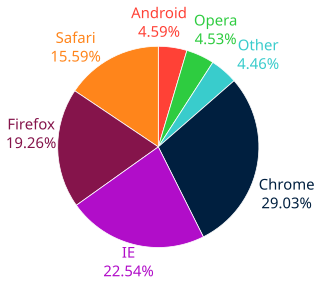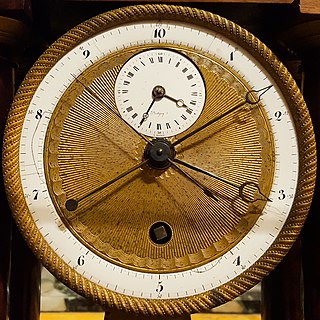
Centime is French for "cent", and is used in English as the name of the fraction currency in several Francophone countries.
Chinese numerals are words and characters used to denote numbers in written Chinese.

The decimal numeral system is the standard system for denoting integer and non-integer numbers. It is the extension to non-integer numbers of the Hindu–Arabic numeral system. The way of denoting numbers in the decimal system is often referred to as decimal notation.
Payload is the object or the entity which is being carried by an aircraft or launch vehicle. Sometimes payload also refers to the carrying capacity of an aircraft or launch vehicle, usually measured in terms of weight. Depending on the nature of the flight or mission, the payload of a vehicle may include cargo, passengers, flight crew, munitions, scientific instruments or experiments, or other equipment. Extra fuel, when optionally carried, is also considered part of the payload.

In mathematics, a percentage is a number or ratio expressed as a fraction of 100. It is often denoted using the percent sign (%), although the abbreviations pct., pct, and sometimes pc are also used. A percentage is a dimensionless number, primarily used for expressing proportions, but percent is nonetheless a unit of measurement in its orthography and usage.

In science and engineering, the parts-per notation is a set of pseudo-units to describe small values of miscellaneous dimensionless quantities, e.g. mole fraction or mass fraction. Since these fractions are quantity-per-quantity measures, they are pure numbers with no associated units of measurement. Commonly used are parts-per-million, parts-per-billion, parts-per-trillion and parts-per-quadrillion. This notation is not part of the International System of Units (SI) system and its meaning is ambiguous.
The Japanese numerals are the number names used in Japanese. In writing, they are the same as the Chinese numerals, and large numbers follow the Chinese style of grouping by 10,000. Two pronunciations are used: the Sino-Japanese (on'yomi) readings of the Chinese characters and the Japanese yamato kotoba.
English number words include numerals and various words derived from them, as well as a large number of words borrowed from other languages.
The New Taiwan dollar is the official currency of the Republic of China. The New Taiwan dollar has been the currency of the island of Taiwan since 1949, when it replaced the old Taiwan dollar, at a rate of 40,000 old dollars per one new dollar. The basic unit of the New Taiwan dollar is called a yuan (圓) and is subdivided into ten chiao (角), and into 100 fen (分) or cents, although in practice both chiao and fen are never actually used.
The mill or mil is a unit of currency, used in several countries as one-thousandth of the base unit. In the United States, it is a notional unit equivalent to a thousandth of a United States dollar. In the United Kingdom, it was proposed during the decades of discussion on decimalisation as a 1⁄1000 division of sterling's pound. While this system was never adopted in the United Kingdom, the currencies of some British or formerly British territories did adopt it, such as the Palestine pound and the Maltese lira.
In computing, fixed-point is a method of representing fractional (non-integer) numbers by storing a fixed number of digits of their fractional part. Dollar amounts, for example, are often stored with exactly two fractional digits, representing the cents. More generally, the term may refer to representing fractional values as integer multiples of some fixed small unit, e.g. a fractional amount of hours as an integer multiple of ten-minute intervals. Fixed-point number representation is often contrasted to the more complicated and computationally demanding floating-point representation.
One millionth is equal to 0.000 001, or 1 x 10−6 in scientific notation. It is the reciprocal of a million, and can be also written as 1⁄1,000,000. Units using this fraction can be indicated using the prefix "micro-" from Greek, meaning "small". Numbers of this quantity are expressed in terms of μ.

A fraction represents a part of a whole or, more generally, any number of equal parts. When spoken in everyday English, a fraction describes how many parts of a certain size there are, for example, one-half, eight-fifths, three-quarters. A common, vulgar, or simple fraction consists of an integer numerator, displayed above a line, and a non-zero integer denominator, displayed below that line. If these integers are positive, then the numerator represents a number of equal parts, and the denominator indicates how many of those parts make up a unit or a whole. For example, in the fraction 3/4, the numerator 3 indicates that the fraction represents 3 equal parts, and the denominator 4 indicates that 4 parts make up a whole. The picture to the right illustrates 3/4 of a cake.
A percentage point or percent point is the unit for the arithmetic difference between two percentages. For example, moving up from 40 percent to 44 percent is an increase of 4 percentage points. In written text, the unit is usually either written out, or abbreviated as pp, p.p., or %pt. to avoid confusion with percentage increase or decrease in the actual quantity. After the first occurrence, some writers abbreviate by using just "point" or "points".

Decimal time is the representation of the time of day using units which are decimally related. This term is often used specifically to refer to the French Republican calendar time system used in France from 1794 to 1800, during the French Revolution, which divided the day into 10 decimal hours, each decimal hour into 100 decimal minutes and each decimal minute into 100 decimal seconds, as opposed to the more familiar standard time, which divides the day into 24 hours, each hour into 60 minutes and each minute into 60 seconds.

The magnitude of eclipse is the fraction of the angular diameter of a celestial body being eclipsed. This applies to all celestial eclipses. The magnitude of a partial or annular solar eclipse is always between 0.0 and 1.0, while the magnitude of a total solar eclipse is always greater than or equal to 1.0, and has a theoretically maximum value of around 1.12.

The céntimo or cêntimo was a currency unit of Spain, Portugal and their former colonies. The word derived from the Latin centimus meaning "hundredth part". The main Spanish currency, before the euro, was the peseta which was divided into 100 céntimos. In Portugal it was the real and later the escudo, until it was also replaced by the euro. In the European community cent is the official name for one hundredth of a euro. However, both céntimo and cêntimo are commonly used to describe the euro cent.
In linguistics, ordinal numerals or ordinal number words are words representing position or rank in a sequential order; the order may be of size, importance, chronology, and so on. They differ from cardinal numerals, which represent quantity and other types of numerals.

The degree Celsius is the unit of temperature on the Celsius temperature scale, one of two temperature scales used in the International System of Units (SI), the other being the closely related Kelvin scale. The degree Celsius can refer to a specific point on the Celsius temperature scale or to a difference or range between two temperatures. It is named after the Swedish astronomer Anders Celsius (1701–1744), who proposed the first version of it in 1742. The unit was called centigrade in several languages for many years. In 1948, the International Committee for Weights and Measures renamed it to honor Celsius and also to remove confusion with the term for one hundredth of a gradian in some languages. Most countries use this scale.








